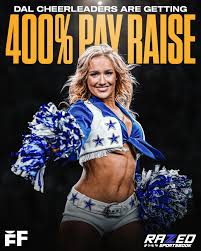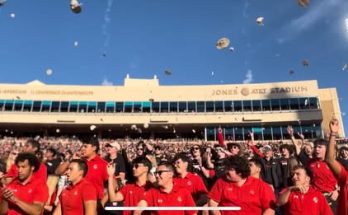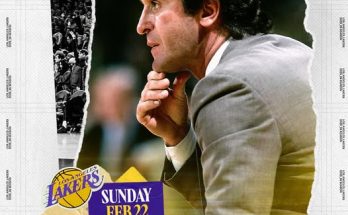The Dallas Cowboys cheerleaders—often regarded as the most iconic and recognizable cheerleading squad in the world—have just secured a historic 400% pay raise, sending shockwaves through the sports and entertainment industries. The groundbreaking development not only marks a transformative moment for the cheerleaders themselves, but it also sets a powerful precedent for other professional cheerleading teams and performers across the nation who have long fought for fair compensation, recognition, and respect.
For decades, the Dallas Cowboys cheerleaders have symbolized glamour, precision, and high-octane performance on the sidelines of NFL games. Their crisp choreography, picture-perfect smiles, and grueling practice schedules have made them household names, even among casual football fans. They’ve graced television screens, calendars, parades, and even USO tours around the world. Yet behind the glitter and fame has always been a more sobering truth: the cheerleaders have historically been grossly underpaid for the work, time, and public persona required of them.
Until now.
With the new pay raise, which elevates their game-day compensation from $200 per game to over $600 and boosts their hourly rehearsal rate significantly, the cheerleaders are finally being compensated in a way that reflects both their value and their contribution to the Dallas Cowboys brand. Sources indicate that the cheerleaders will now earn approximately $25,000 per season, a remarkable leap from the previous average of $5,000 to $6,000. For a group so synonymous with “America’s Team,” this adjustment has been long overdue.
The announcement comes amid a broader cultural shift in the way women in sports, entertainment, and adjacent industries are viewed and valued. For years, cheerleaders across the NFL have been fighting for better pay, improved working conditions, and professional respect. Lawsuits, exposés, and player advocacy have shed light on a system that expected excellence from these women without compensating them adequately for their efforts. Some former Dallas Cowboys cheerleaders even revealed they were making below minimum wage after factoring in the hours of rehearsals, appearances, and travel—much of which wasn’t compensated at all.
But this week, everything changed.
This raise didn’t come out of nowhere. It was the result of years of behind-the-scenes discussions, increasing public pressure, and a renewed commitment from the Dallas Cowboys organization to modernize their approach to employee welfare and equity. Team owner Jerry Jones, never shy of the media spotlight, has yet to issue a detailed statement, but insiders say the front office recognized that the cheerleaders’ contribution to the Cowboys’ brand equity is undeniable. From national TV features to branded merchandise, the Dallas Cowboys Cheerleaders (DCC) have become an indispensable part of the franchise’s massive cultural footprint.
For many cheerleaders—past and present—this moment is nothing short of vindication.
“This is a game-changer,” said a former DCC member who preferred to remain anonymous. “We poured our hearts into the role, gave up time with family, made public appearances on behalf of the team, and were constantly under the microscope. The expectations were sky-high, but the pay didn’t match. This new deal? It changes everything.”
What makes this pay raise even more significant is that it comes at a time when the Cowboys are redefining their approach to branding and fan engagement. With the NFL entering a new media age and expanding its global reach, the Cowboys have leaned heavily into their legacy symbols—none more iconic than the DCC. Whether it’s Netflix documentaries, international exhibition games, or major marketing campaigns, the cheerleaders have become central to the team’s storytelling.
This bold financial move, then, is as much a business decision as it is a moral one. The cheerleaders represent a multi-generational fanbase, one that grew up idolizing the precision, style, and presence of the DCC. Elevating their pay is an investment in the Cowboys’ image, its fan engagement, and its future.
Critics might argue that $25,000 per season is still a relatively modest figure compared to the millions made by players, coaches, and executives. But the context matters. A 400% increase is seismic in the cheerleading world—where most professional squads across the NFL still compensate their cheerleaders minimally, and in some cases below legal wage thresholds. The Cowboys, long known for being trailblazers in branding, now become leaders in cheerleader compensation too.
Cheerleading is a demanding discipline. It requires athleticism, endurance, memorization, time commitment, and unrelenting poise under pressure. DCC members practice multiple times per week, perform in front of nearly 100,000 fans each game, and are required to maintain peak physical and aesthetic standards throughout the year. Add to that their extensive schedule of community events, charity appearances, and corporate functions, and it becomes clear: this is more than just dancing on Sundays—it’s a full-time brand ambassador role.
And yet, until now, they were paid like part-timers.
With this new pay raise, the Cowboys are effectively saying: “We see you. We value you. And we’re going to pay you like the professionals you are.”
Fans and activists alike have taken to social media to celebrate the news. The announcement trended on Twitter within hours, with thousands applauding the decision as a long-overdue correction to an exploitative norm. Prominent voices in the women’s rights, labor advocacy, and sports commentary communities have lauded the Cowboys for setting a new benchmark—one they hope other franchises will follow.
“This is more than a victory for the Dallas Cowboys Cheerleaders,” wrote one commentator. “This is a victory for every woman who’s ever been told her contributions don’t count because they don’t show up on the stat sheet.”
NFL Commissioner Roger Goodell has not commented publicly on the raise, but pressure is now likely to mount on the league as a whole to examine how cheerleaders are treated league-wide. If the NFL truly wants to position itself as a leader in equity, inclusion, and player welfare, addressing cheerleader compensation across all 32 teams would be a logical next step.
Within the Cowboys’ own community, the ripple effects are already being felt. Team officials say morale among the cheerleaders is at an all-time high, with incoming rookie hopefuls expressing renewed excitement about joining an organization that’s willing to back up its brand with action.
For years, the Dallas Cowboys cheerleaders were held up as the gold standard in NFL cheerleading—glamorous, visible, polished. Now, they’re setting a new standard in how sideline entertainers are treated as professionals. It’s a shift that could reverberate far beyond AT&T Stadium, potentially igniting a wave of similar changes across other sports leagues and entertainment industries where undercompensation is still the norm.
The cheerleaders are no longer just the sparkling faces of halftime entertainment; they are now the front-runners in a movement for economic justice within the sports-entertainment complex. Their triumph sends a message not just to other cheerleaders, but to every undervalued performer in America: with persistence, visibility, and unity, the system can change.
As the 2025 NFL season approaches, the Cowboys will hit the field with high expectations, chasing their elusive Super Bowl dreams. But off the field, they’ve already made a championship-caliber move—one that will echo across locker rooms, boardrooms, and sidelines for years to come.
And when the cheerleaders take the field this season, they’ll be doing so not just with pom-poms and smiles—but with paychecks that finally reflect the power, presence, and professionalism they bring to the game.



